- It is the biggest non-fixed fair in the land and even knocks most permanent ones into a cocked hat. Well over 1 million people attend the fair each year.
- Council workers start marking out The Forest from early August. The biggest pitches cost around ?000 but a popular ride can take up to ?,600 per hour!
- The official opening is signified at noon on the first day by The Lord Mayor of Nottingham ringing a pair of silver bells after the Chief Executive and Town Clerk has read the Proclamation in the presence of the Sheriff of Nottingham.
- The Fair, including the showmen's living vans, covers about 18 acres. There are around 55 riding machines plus another 40 or so for children. A further 225 games stalls invite the public to have-a-go.
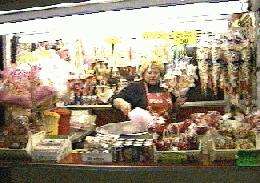 A further 400 stalls sell novelties, luminous bangles are always a favourite, as well as the all-important refreshments. The aroma of the unique blend of Goose Fair foods fills the air; hot dogs, mushy peas (with mint sauce of course), cock-on-a-stick, candy floss, toffee apples, brandy snap and coconuts!
A further 400 stalls sell novelties, luminous bangles are always a favourite, as well as the all-important refreshments. The aroma of the unique blend of Goose Fair foods fills the air; hot dogs, mushy peas (with mint sauce of course), cock-on-a-stick, candy floss, toffee apples, brandy snap and coconuts! There are another dozen side shows with such attractions as 'Tiny Tim', 'Britains Tallest Man' and one of the few boxing booths still in operation.
- No-one really knows exactly how many centuries The Fair has existed, though it is thought that The Danes established a market/fair in Nottingham over a thousand years ago. The first official recognition came when King Edward I granted Goose Fair a charter in 1284 to mark the Feast of St. Matthew. (Until 1752 the fair was always be held on St. Matthew's Day : 21st September.)
- When the calendar was revised in 1752, omitting 11 days from September, the date of Goose Fair was switched to October 2nd and this remained until 1875.
- The Fair has failed to take place on only 11 occasions since being made 'official' in 1284. The plague of 1646 intervened and there was also the matter of two World Wars, though it was back by 1944, albeit only during the day to avoid the blackout.
- These pictures show some of the first scenes to be captured on film. We can see the old flat-roofed Coucil House in this shot of 1908.
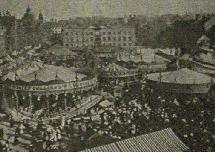
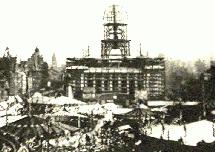 By 1927 the new Council House was almost complete but not even the building work could stop Goose Fair, though it was soon to be moved from the Market Square.
By 1927 the new Council House was almost complete but not even the building work could stop Goose Fair, though it was soon to be moved from the Market Square.
- Unsurprisingly, it all began with geese! Thousands of them were herded into The Market Square each year to be sold for the feast of St. Matthew. Some were walked from Lincoln and Norfolk, more than a hundred miles away, their feet coated in tar and sand as make-shift shoes.
- As geese went out of fashion on the dinner table the sideshows which had grown up around the fair became attractions in their own right. Waxwork exhibitions became popular in the late 1700s and animal shows became attractions too. Comedians, clowns, dancing bears, bearded ladies and the new-fangled camera obscura all drew the crowds.
- In the early nineteenth century, hand-turned merry-go-rounds started to appear. At first the Council wasn't impressed. In fact it banned them, condeming them as "disgraceful and dangerous machines; instruments of folly and immodesty!" But public opinion won through and they soon became extremely popular - and faster - with the advent of steam engines in 1865.
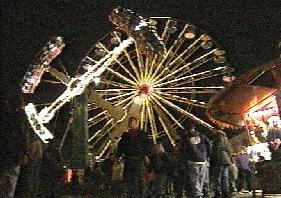
The helter skelter debuted in 1906. The following year welcomed 'The Big Wheel'.
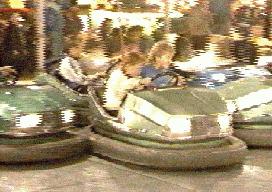
In 1908 the Cakewalk put in its first appearance. By 1911 electricity was available on-site and an electric railway was a crowd-pleaser. The dodgems were soon to follow.
- In 1928 it was decided that the fair had outgrown the Market Square and it was transfered a mile up the road to 'The Forest' recreation ground.
- The fair originally lasted for eight days, though this was shortened to five days in 1876 when it was decided that it no longer served any useful trading purpose. Four years later it was shortened to three days and this is how it has stayed since, though in 1994 the event was granted a one-off extension of two extra days to celebrate it's 700th appearance.
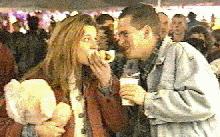 The fact that the fair has lasted for so long is an indication of its popularity amongst local people. But it is impossible to explain in writing and pictures what makes Goose Fair so special. Local people talk of 'Goose Fair weather' when the nights begin to draw in and there's a hint of autumn in the air. Add to that the cocktail of smells (all that food and the busy generators), sounds (driving music, ringing bells, shouting stall-holders and rumbling carriages), flashing lights and the smiling faces of those people who've just won a prize or had their heart pushed up into their mouth by the ghost train or speeding ride and you begin to get the idea. This must be one of the only events on earth that attracts the youngest toddlers, the 'coolest' teenagers and wordly-wise adults in equally great numbers.
The fact that the fair has lasted for so long is an indication of its popularity amongst local people. But it is impossible to explain in writing and pictures what makes Goose Fair so special. Local people talk of 'Goose Fair weather' when the nights begin to draw in and there's a hint of autumn in the air. Add to that the cocktail of smells (all that food and the busy generators), sounds (driving music, ringing bells, shouting stall-holders and rumbling carriages), flashing lights and the smiling faces of those people who've just won a prize or had their heart pushed up into their mouth by the ghost train or speeding ride and you begin to get the idea. This must be one of the only events on earth that attracts the youngest toddlers, the 'coolest' teenagers and wordly-wise adults in equally great numbers.

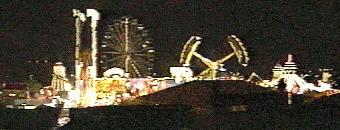
 A further 400 stalls sell novelties, luminous bangles are always a favourite, as well as the all-important refreshments. The aroma of the unique blend of Goose Fair foods fills the air; hot dogs, mushy peas (with mint sauce of course), cock-on-a-stick, candy floss, toffee apples, brandy snap and coconuts!
A further 400 stalls sell novelties, luminous bangles are always a favourite, as well as the all-important refreshments. The aroma of the unique blend of Goose Fair foods fills the air; hot dogs, mushy peas (with mint sauce of course), cock-on-a-stick, candy floss, toffee apples, brandy snap and coconuts! 
 By 1927 the new Council House was almost complete but not even the building work could stop Goose Fair, though it was soon to be moved from the Market Square.
By 1927 the new Council House was almost complete but not even the building work could stop Goose Fair, though it was soon to be moved from the Market Square.

 The fact that the fair has lasted for so long is an indication of its popularity amongst local people. But it is impossible to explain in writing and pictures what makes Goose Fair so special. Local people talk of 'Goose Fair weather' when the nights begin to draw in and there's a hint of autumn in the air. Add to that the cocktail of smells (all that food and the busy generators), sounds (driving music, ringing bells, shouting stall-holders and rumbling carriages), flashing lights and the smiling faces of those people who've just won a prize or had their heart pushed up into their mouth by the ghost train or speeding ride and you begin to get the idea. This must be one of the only events on earth that attracts the youngest toddlers, the 'coolest' teenagers and wordly-wise adults in equally great numbers.
The fact that the fair has lasted for so long is an indication of its popularity amongst local people. But it is impossible to explain in writing and pictures what makes Goose Fair so special. Local people talk of 'Goose Fair weather' when the nights begin to draw in and there's a hint of autumn in the air. Add to that the cocktail of smells (all that food and the busy generators), sounds (driving music, ringing bells, shouting stall-holders and rumbling carriages), flashing lights and the smiling faces of those people who've just won a prize or had their heart pushed up into their mouth by the ghost train or speeding ride and you begin to get the idea. This must be one of the only events on earth that attracts the youngest toddlers, the 'coolest' teenagers and wordly-wise adults in equally great numbers.